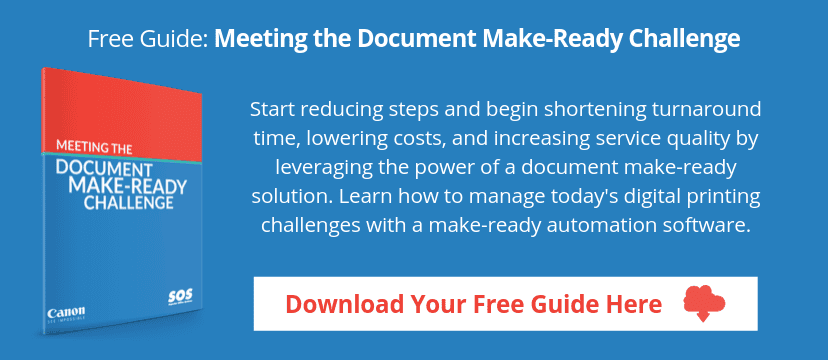In-Plant Print Production: How to Boost Efficiency & Value
If you’re managing an in-plant print production or CRD team, the future of your operation may be a nagging concern. It’s getting more and more difficult for internal print production operations to keep providing value to their organization, due to:
- Lacking the range of capabilities that commercial print production shops have
- Costs that bring your department’s value into question
- Traditional print being replaced with digital communication
Waiting for the ax to fall is an agonizing position to be in. But there are steps you can take to provide more value to your organization and prevent your department from being downsized or even completely closed down.
Improve customer experience while cutting print production costs
You might think that preventing a decision to outsource your company’s print production is all about cutting costs. That’s certainly a big factor. However, customer experience is just as important.
If decision-makers see your organization as difficult to deal with, slow to respond, and lacking the ability to meet the changing needs of the people you support, that experience makes it more likely that you’ll be replaced with an outside commercial printer.
The good news is, you can cut costs and improve customer experience at the same time. Here’s how.
Understand your customers’ needs
Communication is changing fast, and not only shifting from print to digital. The volume of messages people are bombarded with every day has increased exponentially, making it much more difficult to make an impact with any type of communication.
As a result, your internal customers are constantly forced to shift their communication strategies. For example, they may want to create more personalized marketing pieces, try new distribution sources, or integrate print with digital information.
These strategies can impact their print needs. They might need you to be able to work with databases, print on new substrates, and turnaround projects faster.
The point is, you need to stay on top of the changing needs of the people and departments that you serve. Send customer surveys, set up a mechanism to receive regular feedback, and reach out to department managers regularly to stay in touch with what they are doing.
Automate job submission
If your print production operation has been in place for a while, chances are you have users submitting jobs in a variety of ways: by email, in person, and even by phone. Translating those variable requests into a final product that satisfies the customer can be very challenging. It’s easy to misunderstand what they want. Their files might be incomplete. And the manual process slows everything down.
An automated job submission system solves all these problems, while also freeing up your staff’s time. Best of all, it makes things quick and easy for your customers.
Read this related article to learn more: 11 Reasons to Automate Print Job Submission
Create prepress workflows that reduce cost & turnaround time
Job submission is not the only area where automation can cut costs and make your operation more productive. In fact, there are many tasks that requires your operation to stop for manual fixes that eat up time and money:
You can eliminate many of these time-consuming steps with various levels of workflow automation.
Templates for recurring jobs. For jobs you print regularly, such as business cards, providing a template eliminates errors and saves time. You can also provide templates with “controlled flexibility” that allow for creativity and multiple uses while limiting variables.
Learn more: Simplify and Speed Workflow Using Print Job Templates
Print workflow management software. Workflow automation tools like Canon Make-Ready can reduce, if not eliminate entirely, most of the challenges that digital press operations face in their prepress work, including preflighting, finishing and tracking the progress of jobs. It frees up your staff to do more valuable work, reduces errors that waste money and disappoint customers, and improves turnaround time.
Learn more: 6 Steps to Improve Digital Press Workflow
Prevent downtime with equipment maintenance
Nothing can set you back faster than an equipment breakdown. Being unable to produce for days or longer increases costs and disappoints your customers.
The easiest and most effective way to keep your operation running smoothly and prevent equipment problems is to have your system maintained regularly by experts.
To learn about the service frequency experts recommend and the tasks that must be included in digital press maintenance, read this article: Best Practices for Printing Press Maintenance.
If you’re not getting this level of service from your current vendor (and you’re located in the New York City metro area), SOS can help. Contact us anytime to discuss your needs.
Add modern print production services
As we mentioned earlier, your customers’ printing needs are changing and expanding. Chances are, they are looking for some of these printing advancements that you might not be ready to provide:
If you want to prevent your customers from outsourcing their print jobs, it’s time to build the skill sets of your staff. Train your operators in database management, variable data printing, and other modern digital printing capabilities.
You might also need to consider investing in equipment that can handle a wider range of substrates, sizes, and finishing options.
Manage peaks and valleys
Does your print production operation tend to have periods where you’re crazy-busy and others where your operators are sitting around with nothing to do? Proactively managing these peaks and valleys helps you be more efficient and meet customer expectations.
When peak periods loom, consider hiring additional freelance operators. Or, build relationships with outsource print shops to handle your overflow. Better for you to control the decision to outsource as needed, then having a failure take the decision out of your hands for good.
During slow periods, consider insourcing. Are there other areas of your business that you could serve? Subsidiaries or business partners that you could take on work for? Also, slow periods are a great time for training your staff and implementing new workflow solutions.
Get help to improve your print production operation
Get this free guide that can help you streamline your print production workflow:




